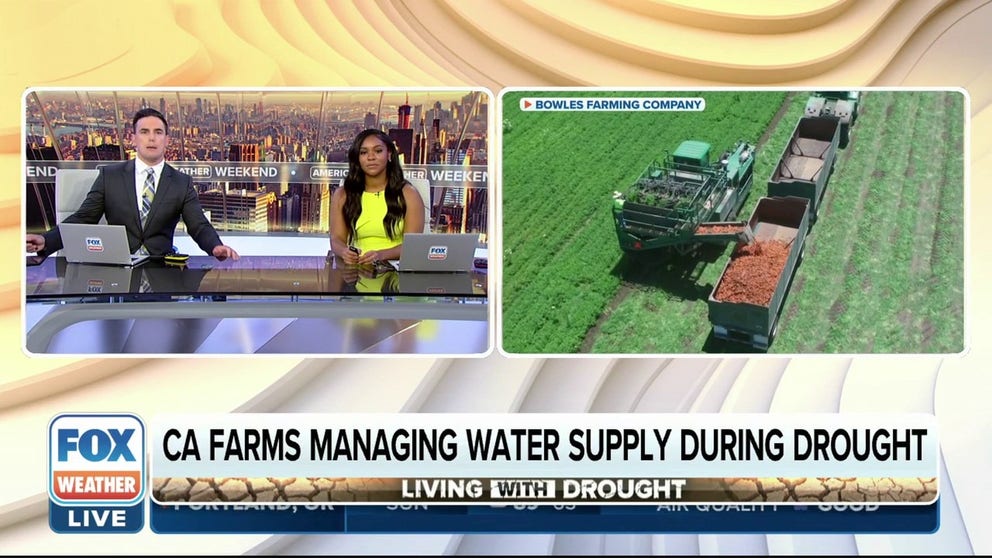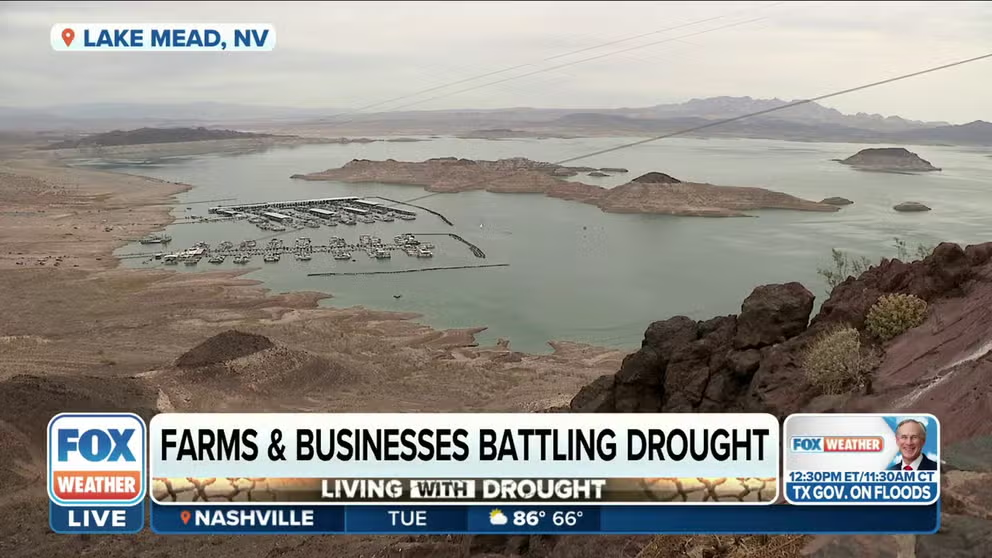High grocery bill? Blame the weather
Because of the drought, some farmers chose not to plant certain crops because of high water needs and a low profit margin which will mean higher costs for some grocery must-haves.
Fewer tomatoes, onions and watermelons due to drought
Western farms cut down on the number of acres of family grocery store staples due to drought. Derek Azevedo of Bowles Farming Company in California explains why dry conditions mean fewer tomatoes, almonds, bell peppers and onions.
As the extreme drought continues across much of the western U.S., farmers have no choice but to cut back on crops. Farmers let their land fallow, ranchers culled cattle, and other farms simply planted less. Because of this, it means higher prices in the grocery stores.
"There certainly were some crops that didn't make it onto the crop plan at all for us," Derek Azevedo, Executive Vice President of the Bowles Farming Company, told FOX Weather. "Especially during drought, studying your water budget much like your financial budget at home and looking for that ROI [return on investment] per acre-foot is a really important metric for us that we study as it relates to choosing the crops that we grow."
ONGOING 22-YEAR DROUGHT IN WESTERN US IS DRIEST PERIOD IN OVER 1,200 YEARS, STUDY FINDS
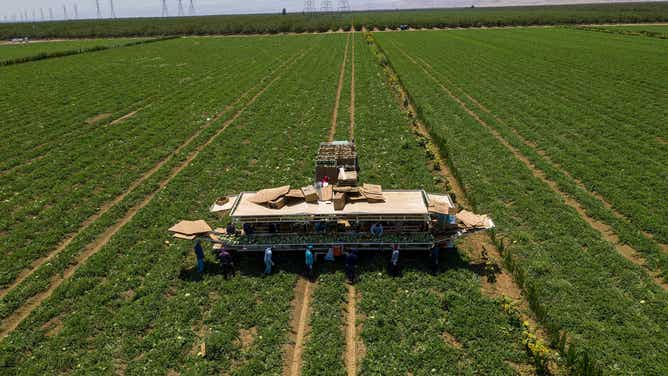
A farmer harvesting cantaloupe on a California farm.
(David Paul Morris/Bloomberg via Getty Images / Getty Images)
California farmers, unlike Midwest farmers that plant and hope for rain, already know their water budget going into a planting year. Planning starts up to two years ahead when Bowles Farming plans crop rotation; where, what and if to plant in each field.
"What's really important is the weather that happened in the previous year and through the winter in the form of rainfall and snow that help recharge our reservoirs and give us ample service water supply," Azevedo continued. "So where you'll see crop yields impacted the most in drought conditions in California is the number of acres that get planted in the first place."
DRIEST JANUARY AND FEBRUARY ON RECORD FOR CALIFORNIA
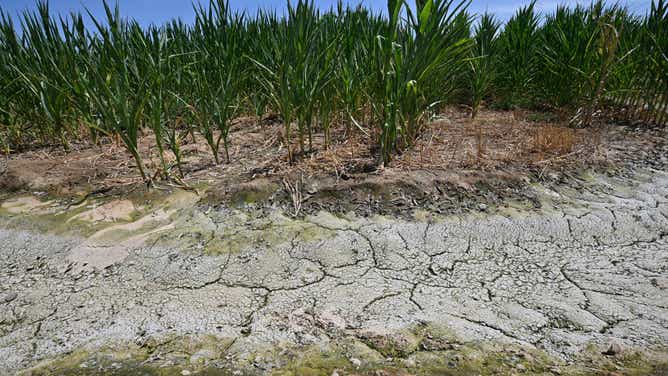
Drought dried this irrigation canal next to a corn field in Fresno, California.
(ROBYN BECK/AFP via Getty Images / Getty Images)
Lower commodity crops cut first
Thirsty tomatoes took a big hit at Bowles Farms. California supplies a quarter of the world's tomatoes.
"That's the biggest reduction in the overall tomato supply this year was the number of acres that were planted in the first place," he said. "[With] the drought conditions, we are seeing a little bit of reduction in the crop. Overall, it sounds like it's about 10% off."
We hear the story echoed across California. A considerable food resource, the Central Valley alone occupies only 1% of the nation's farmland but produces a quarter of the nation's food, according to the U.S. Geological Survey.
"I would say with the drought overall, at my ranch, I am about 15% to 20% short of the acreage that I wanted to plant," Tom Muller, a northern California tomato farmer. "I don't think you'll see a shortage in the stores. I think you are going to have a higher price, though."
CALIFORNIA TOMATO FARMERS WORRIED EXTREME DROUGHT WILL INCREASE PRICES FOR SAUCE, KETCHUP
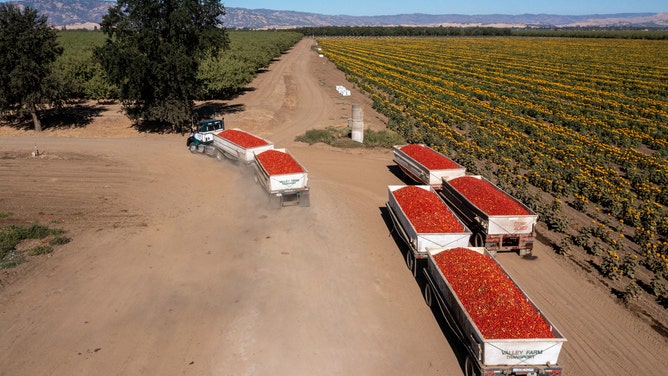
Trucks full after the tomato harvest in Winters, California.
(David Paul Morris/Bloomberg via Getty Images / Getty Images)
"Those are the crops that take most of the heat, the lower value commodities," Professor Josue Medellin-Azuara of the University of California at Merced explained of crops netting fewer profit dollars per cost to produce. "The Sacramento Valley has a high fallow land [rate]. You can't make a better business case to acquire more costly water."
Medellin-Azuara, who also researches water management, agriculture and resource economics, said niche crops like California rice are sidelined, meaning fewer choices at the store.
Back at the Bowles farms, water-needy crops like grasses (feed for livestock), nuts and citrus were sidelined in favor of root vegetables like garlic, onions and carrots.
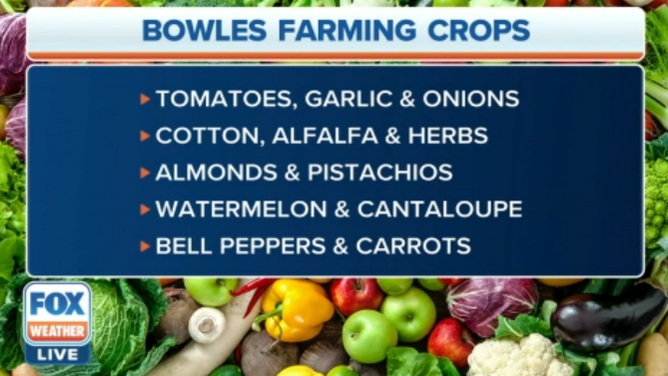
Bowles produces a wide variety of crops and rotates them across their farms based on water availability, economics and weather.
(FOX Weather)
Farmers switch not as water-needy plants and don't plant others
"I'll work in more root vegetables that consume the majority of their water from November through May to kind of spread out that water, demand a little bit and not have a big sort of big surge of water demand in the summertime," explained Azevedo.
FOX Business' Kelly O'Grady reported that a study showed farmers expecting a 74% drop in production over previous years due to the western drought. And, 42% switched or will switch to less-water intensive crops in planting.
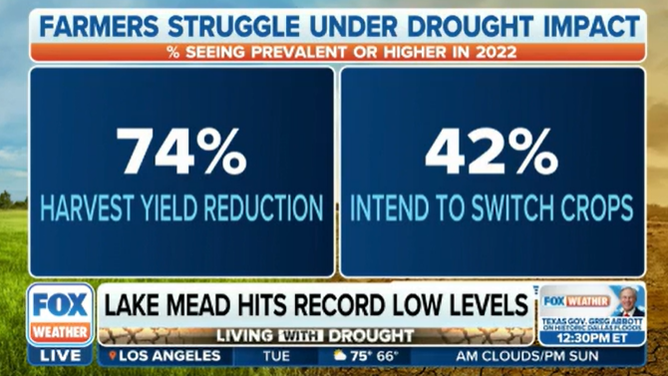
(FOX Weather)
"But by nature, some crops take years of cultivation and investment before they yield anything, and that's spurring some folks to close down altogether," O’Grady told FOX Weather.
Western drought hitting farmers and tourism-business owners hard
FOX Business' Kelly O'Grady reports from Lake Mead on the steps farmers and business owners of lake tourism companies are taking to survive the dry years.
Tree crops like nuts and citrus are also being retired early by farmers, according to satellite images analyzed Medellin-Azuara.
"There's substantial tree removal, and it's some opportunistic removal, once tree has reached 25 or so years [and production drops]," Medellin-Azuara said.
But, nuts are a high-value commodity, so farmers thin old trees instead of changing crops.
What are high value commodity crops?
Top 10 earning commodities, high value commodities, in California farming (California Department of Food and Agriculture or CDFA):
- Dairy Products, Milk — $7.47 billion
- Almonds — $5.62 billion
- Grapes — 4.48 billion
- Pistachios — $2.87 billion
- Cattle and Calves — $2.74 billion
- Lettuce — $2.28 billion
- Strawberries — $1.99 billion
- Tomatoes — $1.20 billion
- Floriculture — $967 million
- Walnuts — $958 million
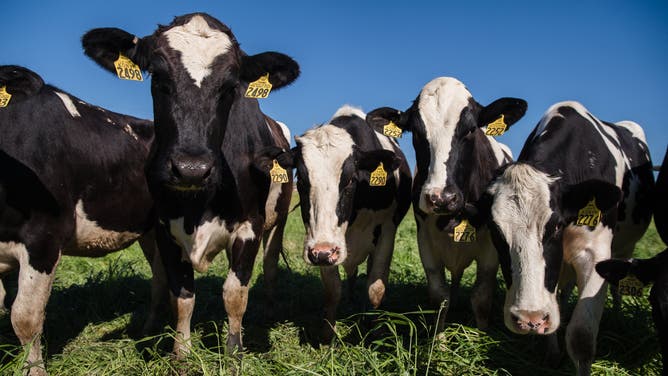
Cows at a dairy farm.
(ARIANA DREHSLER/AFP via Getty Images / Getty Images)
Even though cattle is a high-value commodity, farmers are cutting back. CDFA reports that hay production, vital to the cattle industry, dropped by 29% from 2020 to 2021. It follows that farmers need to cull their herds and beef prices are on their way up.
AMERICAN RANCHERS BLAME DROUGHT FOR HIGHER MEAT PRICES AT GROCERY STORES
Olive, safflower, garbanzo bean and chili pepper production dropped 30-60%. The CDFA also notes a drop in spinach, cotton, and asparagus production by 23-28%.
CHICKPEA DIP: EXTREME WEATHER CONDITIONS AFFECTING POPULAR SUPERFOOD CROP
Oat production, on the other hand, grew 150% from 2020 to 2021. Avocado production was up 73%, pistachios up 41%, leaf lettuce up 30% and almonds up 22%.
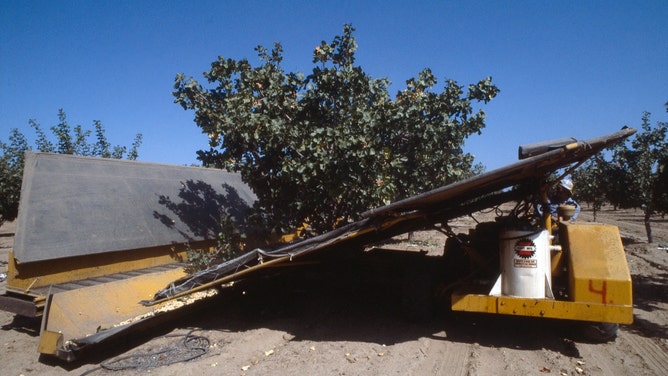
Farmers shake pistachio trees and collect fallen nuts to harvest.
( Getty Images/Bob Riha, Jr / Getty Images)
The California breadbasket - emptied by drought
The California Department of Resources estimated that an average year the state irrigates 9.6 million acres of agriculture with 34 million acre-feet of water. They say the amount would cover 31 million football fields in a foot of water.
Medellin-Azuara says that 80% of California’s water goes to irrigating (forest land included), and 20% goes to cities.
But, California drastically lowered and sometimes eliminated water allotments from reservoirs and groundwater. Farmers are still waiting to hear about Colorado River allotments that need to be cut by 2 to 4 million acre-feet. Arizona alone lost over 21% of its water allotment from the system.
WATER CUTS ORDERED ALONG COLORADO RIVER IN RESPONSE TO DROUGHT CRISIS
California’s most profitable crops are also some significant water users, like pistachios and almonds. Take a look at the list of the most water-intensive crops. Water needed is measured in cumulative water depth required for the growing season, according to the Pacific Institute, a global water think tank. Water intensity takes into account the plant’s requirements for water as well as weather conditions.
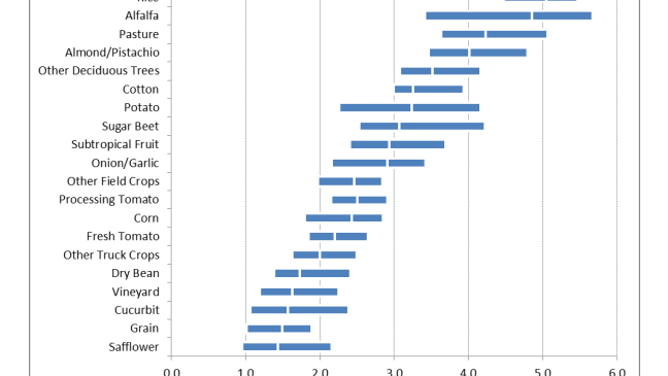
The graph shows the 20 most common crops grown in California and the average depth of water applied to the crop through the growing season, water intensity. Rice and alfalfa require the most water per year and safflower the least.
(Pacific Institute)
Alfalfa and pastureland, the top three water-consuming crops along with corn, primarily go to the cattle industry in California. Dairy products, the leading valued commodity, add $7.47 billion to the economy. Cattle and calves bring in $2.74 billion annually and place fifth on the list.
California produces 99% of the nation’s pistachios and 25% of the world’s needs, according to CDFA’s 2020 figures. The water-intensive crop brings $2.87 billion to the state, the number four moneymaking crop commodity.
Almonds bring the state $5.62 billion, the number two most valued commodity. The state satisfies 80% of worldwide demand, per the Almond Board of California.
Grapes place number three on the commodity list bringing in $4.48 billion annually. Tomatoes only bring in $1.2 billion annually and are the eighth most valuable commodity to the state.
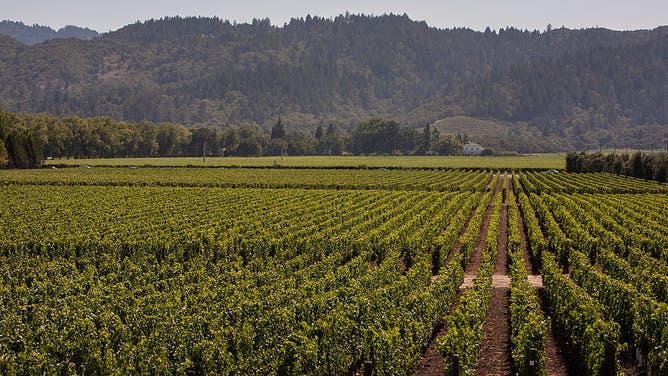
An Opus One vineyard in Napa, California.
(George Rose/Getty Images / Getty Images)
Over a third of the U.S.’ vegetables, two-thirds of fruits and nuts, come from California.
California farmers and ranchers brought in $49.1 billion in cash receipts in 2020, up 3.3% from 2019 despite the drought.
EXCEPTIONAL DROUGHT HITS TOP US BARLEY PRODUCER
Food prices are heading up
Americans are paying more for food – the latest Consumer Price Index for Food grew by 10.4% in the past year, according to the U.S. Department of Agriculture. Grocery store prices increased 12.2%, and restaurant food was 7.7% higher.
The Food Price Outlook for 2022 forecasts that grocery prices will rise an additional 2-3% while restaurant prices will rise 3-4% more this year. Beef and veal showed the steepest price increase of 9.3%, while fresh vegetables only saw a 1.1% price hike. These numbers also include inflation, supply chain issues, and higher transportation, energy, and labor costs. Not all increases are attributable to drought.
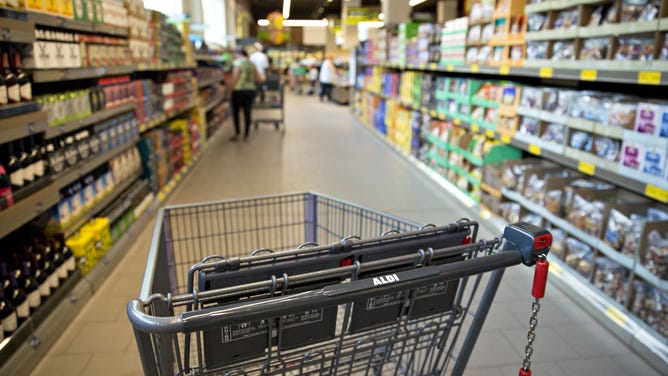
Drought is pushing up food prices.
(Daniel Acker/Bloomberg via Getty Images / Getty Images)
Forecast price rises for year, according to the USDA:
- Poultry 14.5-15.5%
- Seafood 9.5-10.5%
- Dairy 12-13%
- Fats and oils 16.5-17’5%
- Processed fruits and vegetables 8.5-9.5%
- Sugar and sweets 7.5-8.5
- Cereals and bakery products 12-13%
- Non-alcoholic beverages 7.5-8.5
DROUGHT COULD CUT OKLAHOMA'S WHEAT PRODUCTION BY HALF
What does the future hold for farmers and food?
Farmers will strategically rotate crops according to the temperature and water supply in the short term. This may mean less selection for specific varieties of products at the supermarket but not create a food shortage.
Long term, farmers have already come a long way in producing more economical products.
"We're heavily invested in the most efficient irrigation systems with science and technology that allow us to grow the most productive crops with the least amount of water," Azevedo said. "For instance, we're growing those with less than a two feet per acre of water, which is a really big reduction from where we were just 15 to 20 years ago."
Legislators and policymakers continue to develop new water storage opportunities, aquifer recharge, wastewater recycling and desalination.
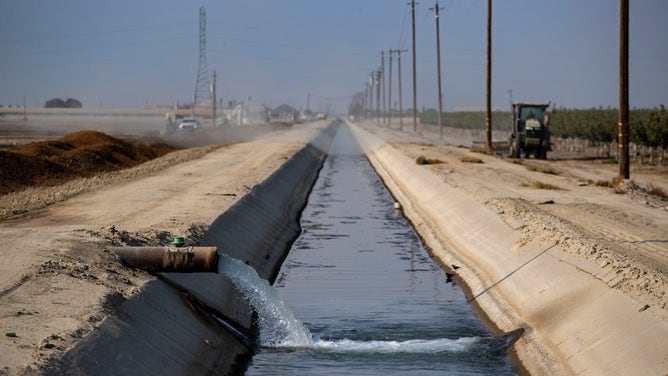
HELM, CA - While the aqueduct and the aquifer filling it is on the Terranova Ranch, the ranch has no legal rights to the water.
(Brian van der Brug / Los Angeles Times via Getty Images / Getty Images)
"We're seeing some trend in higher temperatures that creates some stress in your crops. In the long term, we may see multi-annual droughts that are more frequent and intense, but also we might see very wet years in later years, creating opportunities to store water on the ground," said Medellin-Azuara. "But it's estimated to be a 10% water supply shortage in the long term."
"We're going to have to make different food choices as consumers because of the change in drought and temperatures and farmer's bottom line margins," added Medellin-Azuara. "So you might see some changes on the side of the consumer. Perhaps, there will be some educational inquiries to what can be sustainably grown in some places. You may see some changes in the minds, but it is hard to persuade. It will be a matter of choice."
